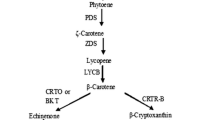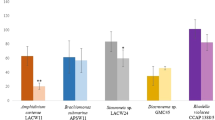Abstract
Astaxanthin, a carotenoid with potent antioxidant effects, is produced by the green alga Haematococcus pluvialis in response to stressful environmental conditions. During encystment several cellular shifts occur, such as the initiation of carotenogenesis and accumulation of reactive oxygen species (ROS) intracellularly. While the presence of ROS during encystment has been established, the effect of ROS on carotenogenesis directly is still primarily unknown. In this study, the relationship between astaxanthin accumulation and ROS production were quantified in H. pluvialis. Cellular astaxanthin and ROS concentrations were measured over 14 days in response to the application of environmental variable, redox-sensitive compound, and ROS-scavenger treatments. Application of both environmental and redox-sensitive treatments induced encystment and carotenogenesis. Initial astaxanthin production rates over days 0–4 were highest in the redox-sensitive variable group, with a subsequent rate peak at days 7–9 for environmental test groups. Cellular ROS concentrations similarly peaked over days 0–4 and 7–9 for redox-sensitive and environmental test groups, respectively. All treatment groups later showed significant decreases in ROS concentration by days 11–14. Furthermore, application of ROS-scavenger treatments induced germination and decreased carotenogenesis rates. By quantifying the relationship between astaxanthin and ROS, this work supports the role of ROS as a modulator of carotenogenesis in H. pluvialis and of astaxanthin as a protective mechanism against oxidative stress. Applications of this study can be further applied to design a more optimized technique of commercial astaxanthin production by combining traditional environmental stress conditions with oxidative stress-inducing factors, reducing natural astaxanthin production time requirements by over 10%.





Similar content being viewed by others
Data availability
All datasets collected or generated during this study are available by reasonable request.
References
Ambati R, Moi P, Ravi S, Aswathanarayana R (2014) Astaxanthin: Sources, extraction, stability, biological activities and its commercial applications - A review. Mar Drugs 12:128–152
Aniya Y, Anders M (1992) Activation of rat liver microsomal glutathione S-transferase by hydrogen peroxide: Role for protein-dimer formation. Arch Biochem Biophys 296:611–616
Badary O, Taha R, El-Din G, Abdel-Wahab M (2003) Thymoquinone is a potent superoxide anion scavenger. Drug Chem Toxicol 26:87–98
Battelli M, Corte E, Stirpe F (1972) Xanthine oxidase type D (dehydrogenase) in the intestine and other organs of the rat. Biochem J 126:747–749
Bhuvaneswari S, Anuradha C (2012) Astaxanthin prevents loss of insulin signaling and improves glucose metabolism in liver of insulin resistant mice. Can J Physiol Pharm 90:1544–1552
Bolann B, Ulvik R (1987) Release of iron from ferritin by xanthine oxidase role of the superoxide radical. Biochem J 243:55–59
Boussiba S (2000) Carotenogenesis in the green alga Haematococcus pluvialis: Cellular physiology and stress response. Physiol Plantarum 108:111–117
Capelli B (2007) Natural astaxanthin: King of the carotenoids. Cyanotech, Kailua Kona
Choi Y, Hong M, Sim S (2015) Enhanced astaxanthin extraction efficiency from Haematococcus pluvialis via the cyst germination in outdoor culture systems. Process Biochem 50:2275–2280
Christiansen R, Lie O, Torrissen O (1995) Growth and survival of Atlantic salmon, Salmo salar L., fed different dietary levels of astaxanthin. First-feeding fry. Aquacult Nutr 1:189–198
Dose J, Matsugo S, Yokokawa H, Koshida Y, Okazaki S, Seidel U, Eggersdorfer M, Rimbach G, Esatbeyoglu T (2016) Free radical scavenging and cellular antioxidant properties of astaxanthin. Int J Mol Sci 17:103
Du F, Hu C, Zhang L, Xu N (2021) Transcriptome analysis reveals the promoting effect of trisodium citrate on astaxanthin accumulation in Haematococcus pluvialis under high light conditions. Aquaculture 543:736978
Fassett R, Coombes J (2011) Astaxanthin: A potential therapeutic agent in cardiovascular disease. Mar Drugs 9:447–465
Foyer C, Shigeoka S (2011) Understanding oxidative stress and antioxidant functions to enhance photosynthesis. Plant Physiol 155:93–100
Fraser P, Miura Y, Misawa N (1997) In vitro characterization of astaxanthin biosynthetic enzymes. J Biol Chem 272:6128–6135
Gao Z, Meng C, Zhang X, Xu D, Zhao Y, Wang Y, Lv H, Yang L, Chen L, Ye N (2012) Differential expression of carotenogenic genes, associated changes on astaxanthin production and photosynthesis features induced by JA in H. pluvialis. PLoS One 7:e42243
Goates C, Knutson K (1994) Enhanced permeation of polar compounds through human epidermis. I. Permeability and membrane structural changes in the presence of short chain alcohols. BBA-Biomembranes 1195:169–179
Goldstein S, Czapski G (1984) Mannitol as an OH· scavenger in aqueous solutions and in biological systems. Int J Radiat Biol Res 46:725–729
Hadjzadeh M, Mohammadian N, Rahmani Z, Rassouli F (2008) Effect of thymoquinone on ethylene glycol-induced kidney calculi in rats. Urol J 5:149–155
He P, Duncan J, Barber J (2007) Astaxanthin accumulation in the green alga Haematococcus pluvialis: Effects of cultivation parameters. J Integr Plant Biol 49:447–451
Hu C, Cui D, Sun X, Shi J, Song L, Li Y, Xu N (2019) Transcriptomic analysis unveils survival strategies of autotrophic Haematococcus pluvialis against high light stress. Aquaculture 513:734430
Ip P, Chen F (2005) Employment of reactive oxygen species to enhance astaxanthin formation in Chlorella zofingiensis in heterotrophic culture. Process Biochem 40:3491–3496
Jomova K, Baros S, Valko M (2012) Redox active metal-induced oxidative stress in biological systems. Transit Metal Chem 37:127–134
Kim Y, Matter I, Lee N, Jung M, Lee Y, Choi S, Lee S, Kim J, Oh Y (2020) Enhancement of astaxanthin production by Haematococcus pluvialis using magnesium aminoclay nanoparticles. Bioresour Technol 307:123270
Kobayashi M, Kakizono T, Nagai S (1993) Enhanced carotenoid biosynthesis by oxidative stress in acetate-Induced cyst cells of a green unicellular alga, Haematococcus pluvialis. Appl Environ Microbiol 59:867–873
Kobayashi M, Kakizono T, Nishio N, Nagai S, Kurimura Y, Tsuji Y (1997) Antioxidant role of astaxanthin in the green alga Haematococcus pluvialis. Appl Microbiol Biot 48:351–356
Lee D, Lee Y (2011) Astaxanthin protects against MPTP/MPP+-induced mitochondrial dysfunction and ROS production in vivo and in vitro. Food Chem Toxicol 49:271–280
Lepetit B, Sturm S, Rogato A, Gruber A, Sachse M, Falciatore A, Kroth P, Lavaud J (2013) High light acclimation in the secondary plastids containing diatom Phaeodactylum tricornutum is triggered by the redox state of the plastoquinone pool. Plant Physiol 161:853–865
Li Y, Sommerfeld M, Chen F, Hu Q (2010) Effect of photon flux densities on regulation of carotenogenesis and cell viability of Haematococcus pluvialis (Chlorophyceae). J Appl Phycol 22:253–263
Li J, Zhu D, Niu J, Shen S, Wang G (2011) An economic assessment of astaxanthin production by large scale cultivation of Haematococcus pluvialis. Biotechnol Adv 29:568–574
Li F, Cai M, Lin M, Huang X, Wang J, Zheng X, Wu S, An Y (2019) Accumulation of astaxanthin was improved by the nonmotile cells of Haematococcus pluvialis. Biomed Res Int 2019:8101762
Lin KH, Lin KC, Lu W, Thomas P, Jayakumar T, Sheu J (2015) Astaxanthin, a carotenoid, stimulates immune responses by enhancing IFN-γ and Il-2 secretion in primary cultured lymphocytes in vitro and ex vivo. Int J Mol Sci 17:44
Martin H, Jäger C, Ruck C, Schmidt M, Walsh R, Paust J (1999) Anti- and prooxidant properties of carotenoids. J Prakt Chemie 341:302–308
März U (2018) The Global Market for Carotenoids. BCC Publishing, Wellesley, Massachusetts, pp 1–146
McCall B, McPartland C, Moore R, Frank-Kamenetskii BB (2018) Effects of astaxanthin on the proliferation and migration of breast cancer cells in vitro. Antioxidants 7:135
Panis G, Carreon J (2016) Commercial astaxanthin production derived by green alga Haematococcus pluvialis: A microalgae process model and a techno-economic assessment all through production line. Algal Res 18:175–190
Park E, Lee C (2001) Astaxanthin production by Haematococcus pluvialis under various light intensities and wavelengths. J Microbiol Biotechnol 11:1024–1030
Park J, Chyun J, Kim Y, Line L, Chew B (2010) Astaxanthin decreased oxidative stress and inflammation and enhanced immune response in humans. Nutr Metab 7:18
Pospíšil P (2016) Production of Reactive oxygen species by photosystem II as a response to light and temperature stress. Front Plant Sci 7:1950
RStudio Team (2020) RStudio: Integrated development environment for R, 1.3.1073 edn., Rstudio, Boston
Schneegurt M (1998) Cyanosite. Bold’s Basal (BB) Medium. World-wide electronic publication, Wichita State University, Wichita. https://www-cyanosite.bio.purdue.edu; searched on 1 November 2019.
Schroeder W, Johnson E (1995) Singlet oxygen and peroxyl radicals regulate carotenoid biosynthesis in Phaffia rhodozyma. J Biol Chem 270:18374–18379
Shah M, Liang Y, Cheng J, Daroch M (2016) Astaxanthin-producing green microalga Haematococcus pluvialis: From single cell to high value commercial products. Front Plant Sci 7:531
Shahidi F, Zhong Y (2015) Measurement of antioxidant activity. J Funct Foods 18:757–781
Shen B, Jensen R, Bohnert H (1997) Mannitol protects against oxidation by hydroxyl radicals. Plant Physiol 115:527–532
Steinbrenner J, Linden H (2003) Light induction of carotenoid biosynthesis genes in the green alga Haematococcus pluvialis: regulation by photosynthetic redox control. Plant Mol Biol 52:343–356
Steinbrenner J (2006) Regulation der Astaxanthinbiosynthese in der Grünalge Haematococcus pluvialis. PhD Thesis, University of Konstanz, 109 pp
Su Y, Wang J, Shi M, Niu X, Yu X, Gao L, Zhang X, Chen L, Zhang W (2014) Metabolomic and network analysis of astaxanthin-producing Haematococcus pluvialis under various stress conditions. Bioresour Technol 170:522–529
Suganya V, Asheeba S (2015) Antioxidant and antimicrobial activity of astaxanthin isolated from three varieties of crabs. Int J Recent Sci Res 6:6753–6758
Sztretye M, Dienes B, Gönczi M, Czirják T, Csernoch L, Dux L, Szentesi K-P (2019) Astaxanthin: A potential mitochondrial-targeted antioxidant treatment in diseases and with aging. Oxid Med Cell Longev 2019:3849692
Tan S, Cunningham F, Youmans M, Grabowski B, Sun Z, Gantt E (2008) Cytochrome f loss in astaxanthin-accumulating red cells of Haematococcus pluvialis (Chlorophyeae): Comparison of photosynthetic activity, photosynthetic enzymes, and thylakoid membrane polypeptides in red and green cells. J Phycol 31:897–905
Vidhyavathi R, Venkatachalam L, Sandesh Kamath B, Sarada R, Ravishankar G (2007) Differential expression of carotenogenic genes and associated changes in pigment profile during regeneration of Haematococcus pluvialis cysts. Appl Microb Biot 75:879–887
Wang B, Zarka A, Trebst A, Boussiba S (2003) Astaxanthin accumulation in Haematococcus pluvialis (Chlorophyceae) as an active photoprotective process under high irradiance. J Phycol 39:1116–1124
Zhang C, Liu J, Zhang L (2017) Cell cycles and proliferation patterns in Haematococcus pluvialis. Chin J Oceanol Limnol 35:1205–1211
Acknowledgements
The authors would like to thank Tryggvi Stefánsson for supplying algal cultures and technical advice, Schonna Manning for algal culture advice, and Jeffrey Walker for statistical analysis assistance.
Funding
This research was supported by the Maine Economic Improvement Fund (6250254) and the University of Southern Maine Department of Biology Graduate Research Fund.
Author information
Authors and Affiliations
Corresponding author
Ethics declarations
Conflict of interest
The authors declare no competing interests.
Additional information
Publisher's note
Springer Nature remains neutral with regard to jurisdictional claims in published maps and institutional affiliations.
Rights and permissions
About this article
Cite this article
Cray, R., Levine, I. Oxidative stress modulates astaxanthin synthesis in Haematococcus pluvialis. J Appl Phycol 34, 2327–2338 (2022). https://doi.org/10.1007/s10811-022-02792-1
Received:
Revised:
Accepted:
Published:
Issue Date:
DOI: https://doi.org/10.1007/s10811-022-02792-1




